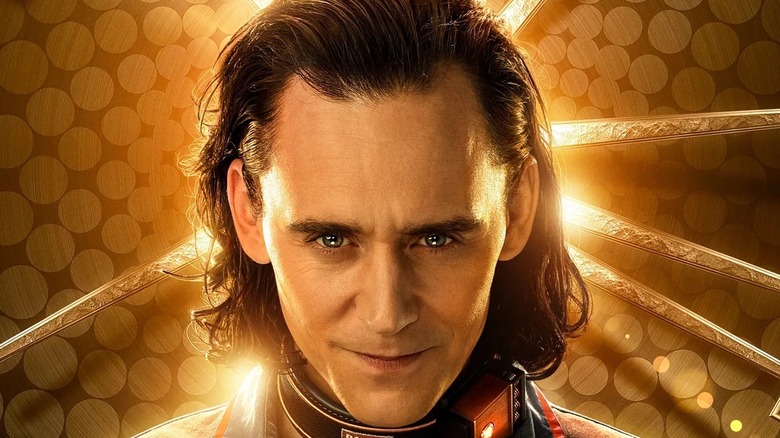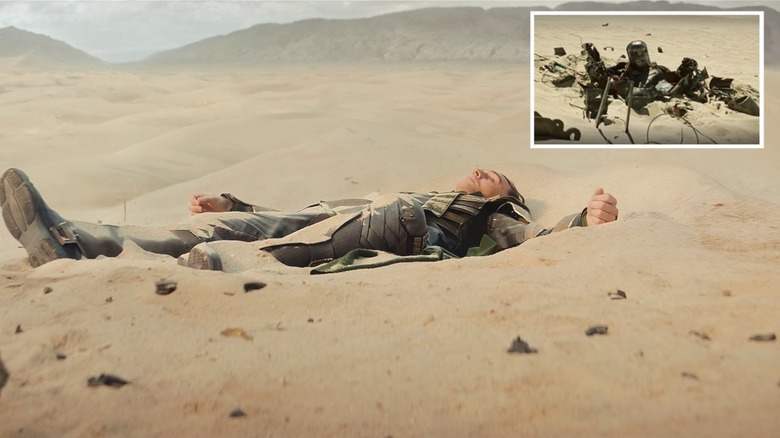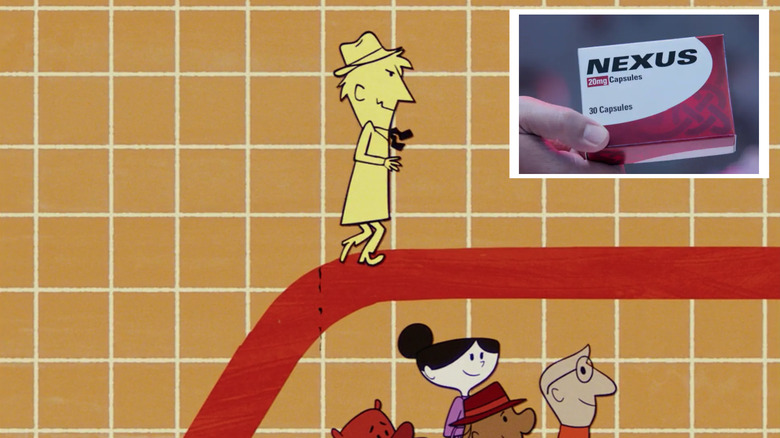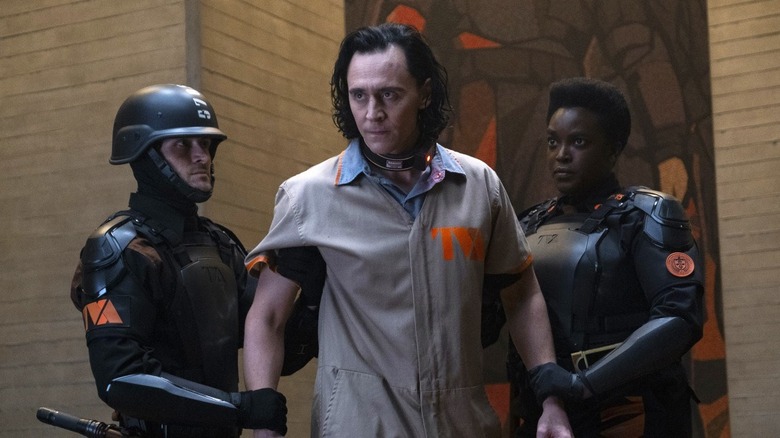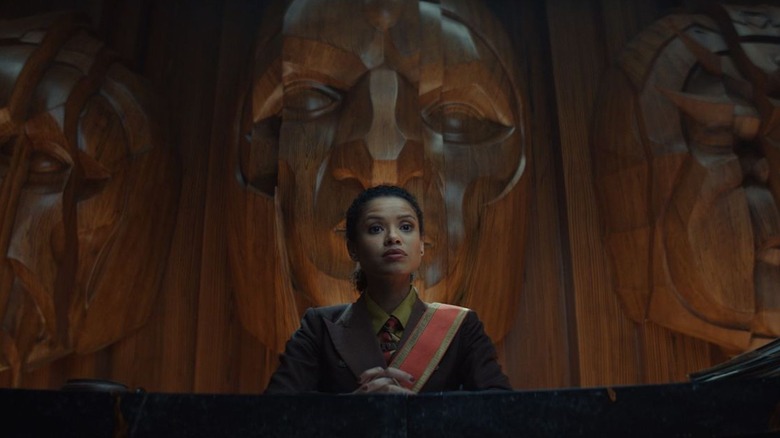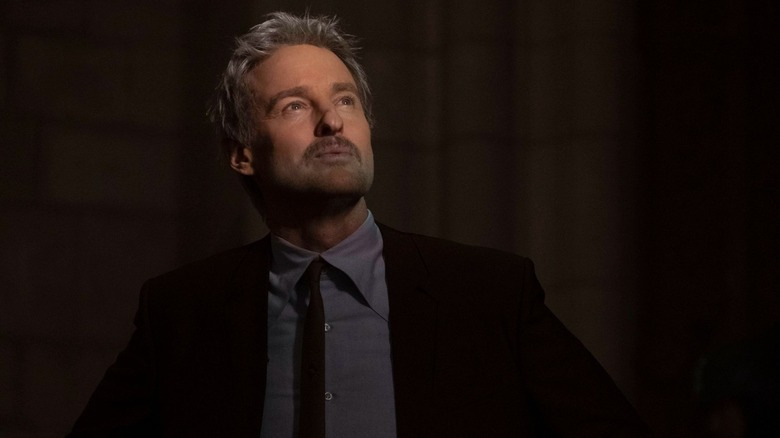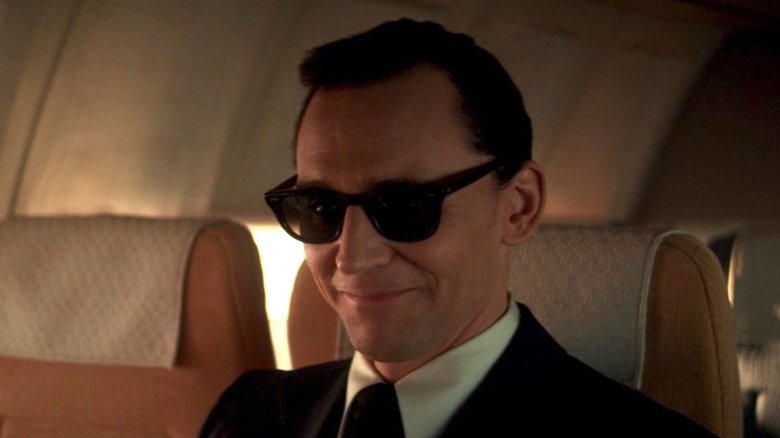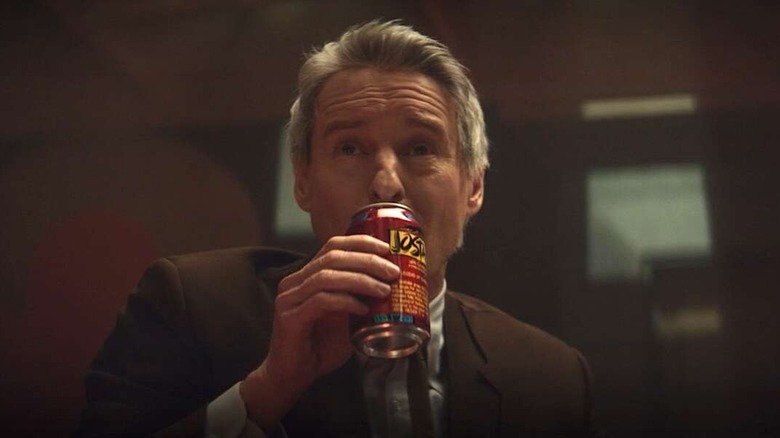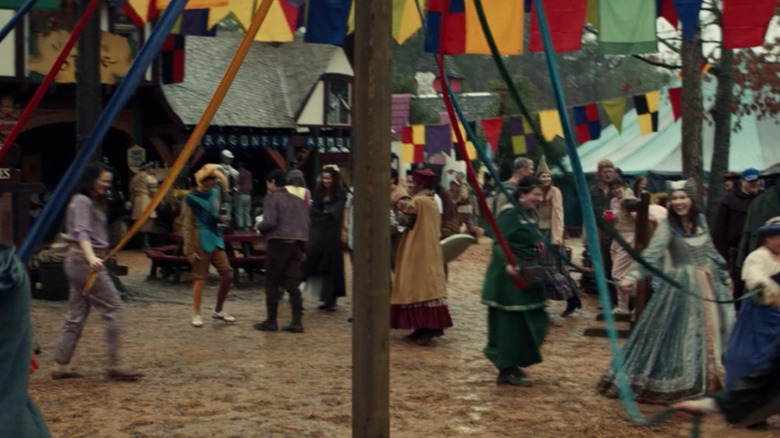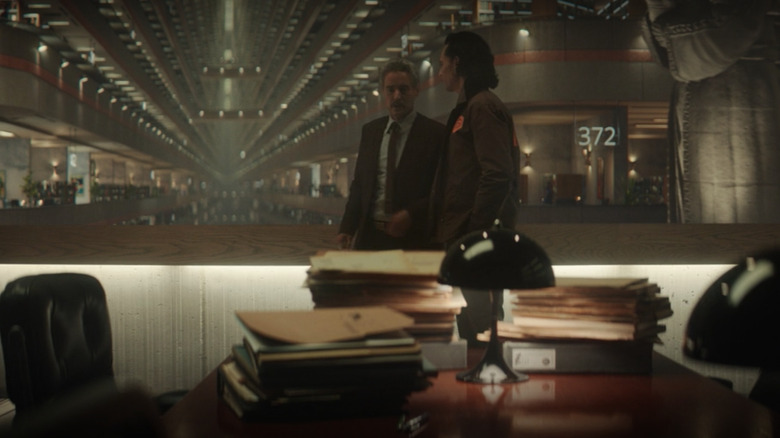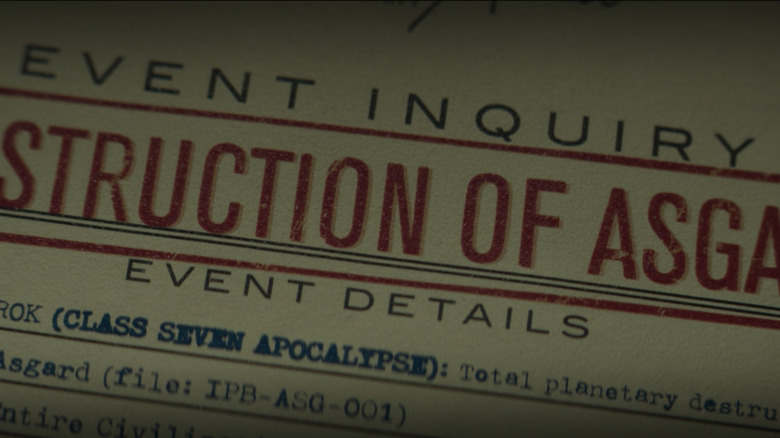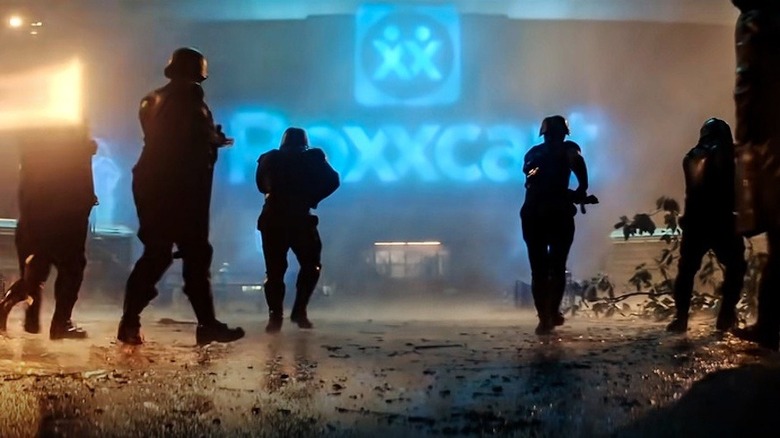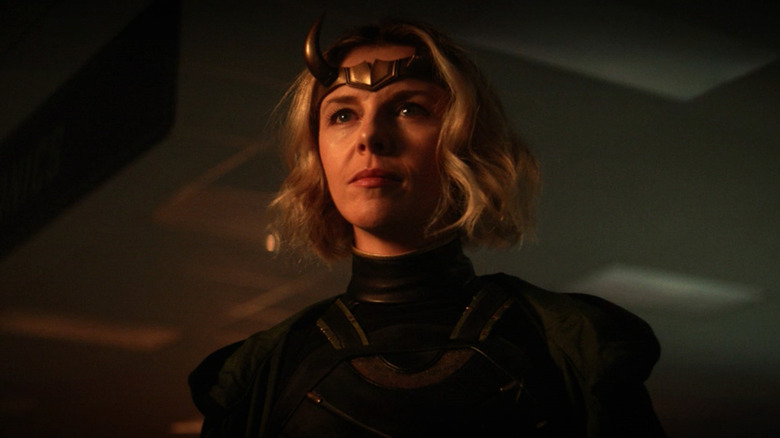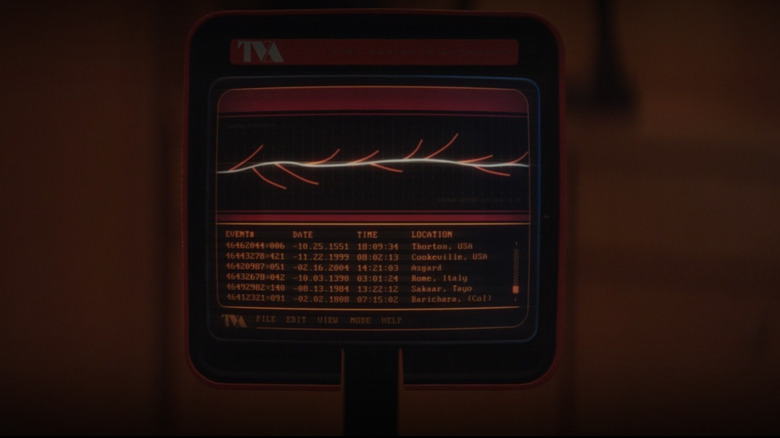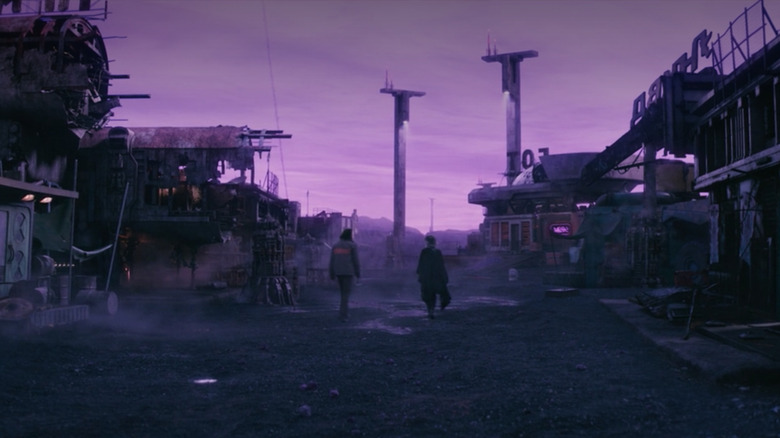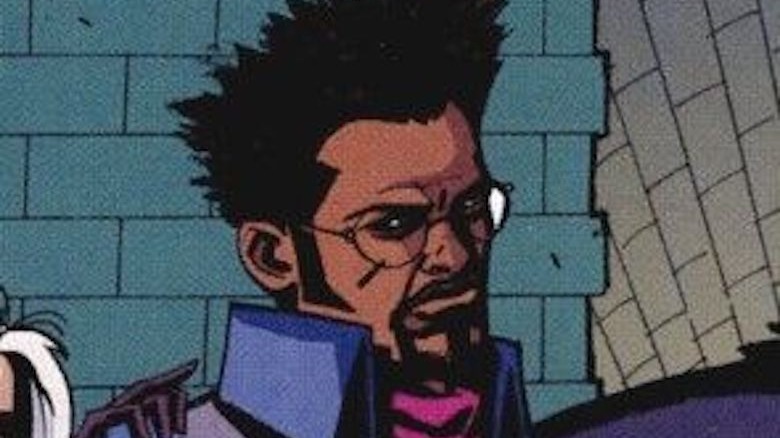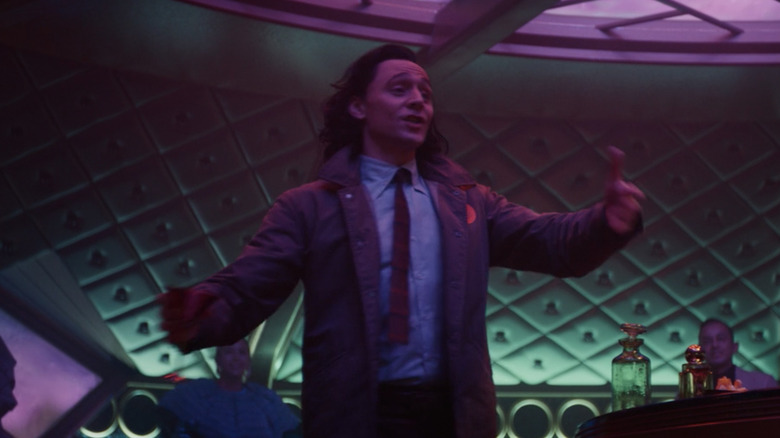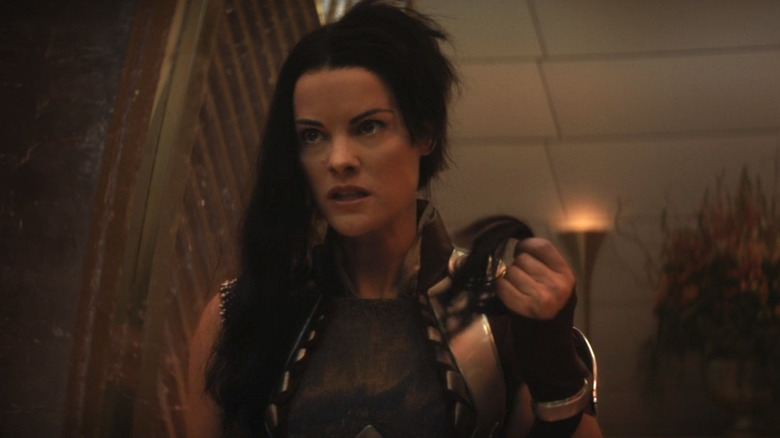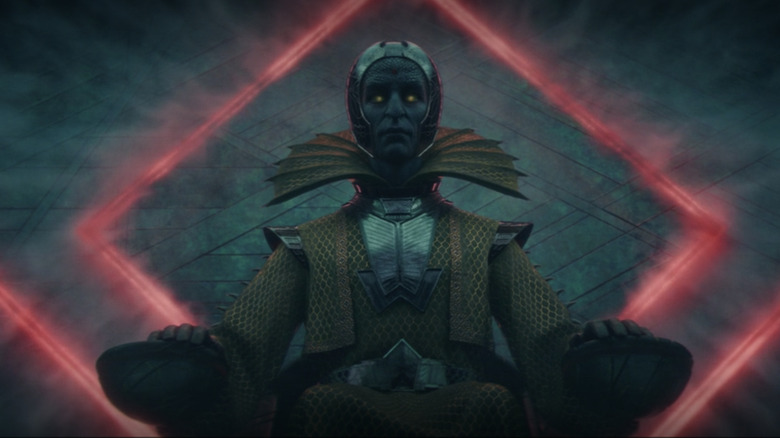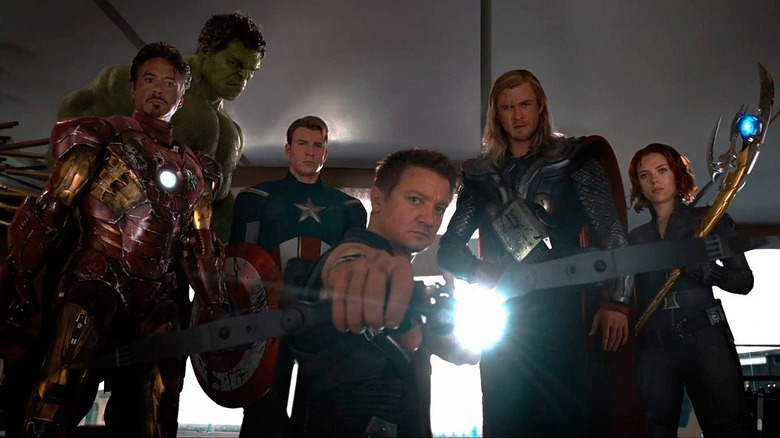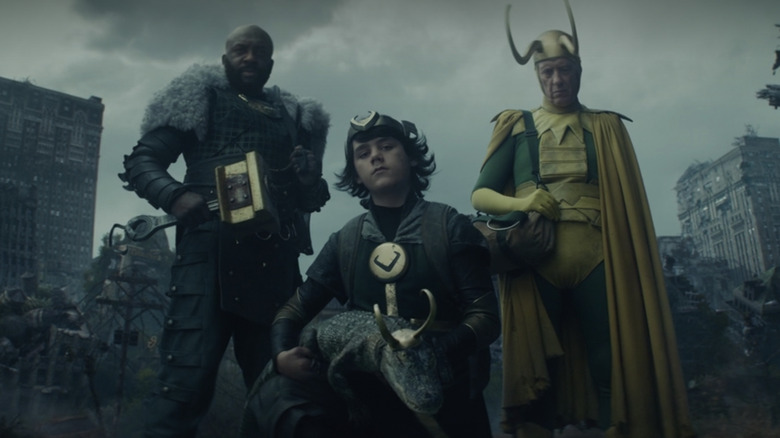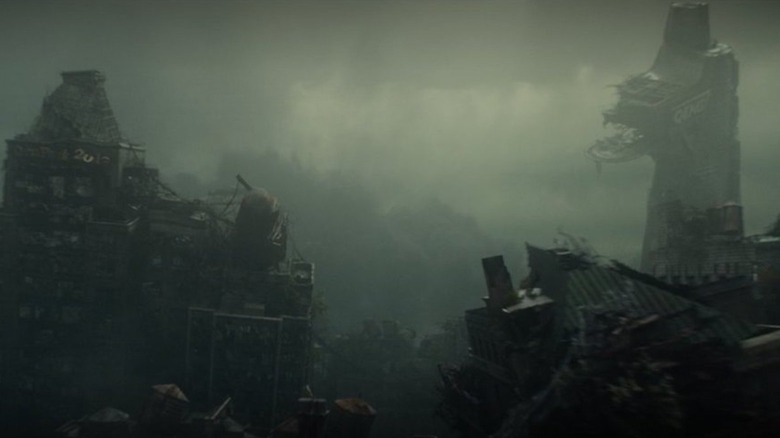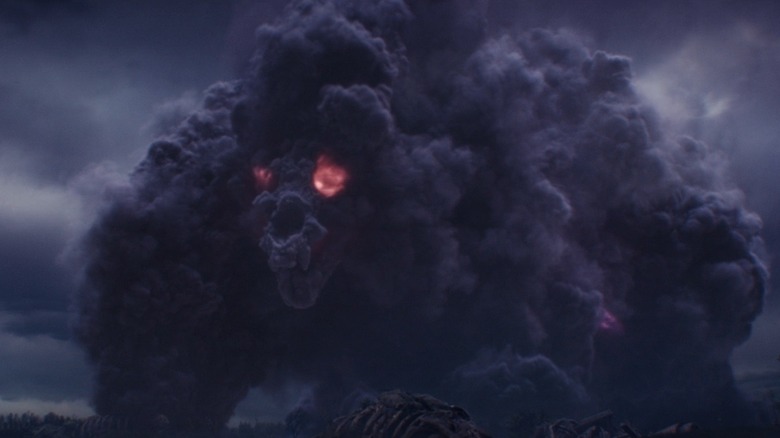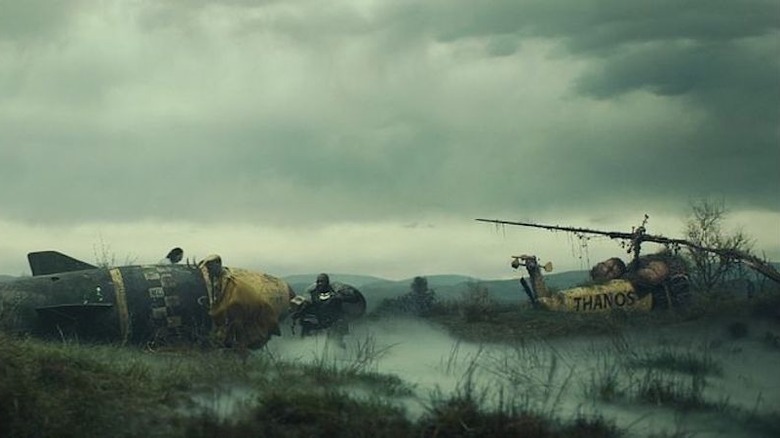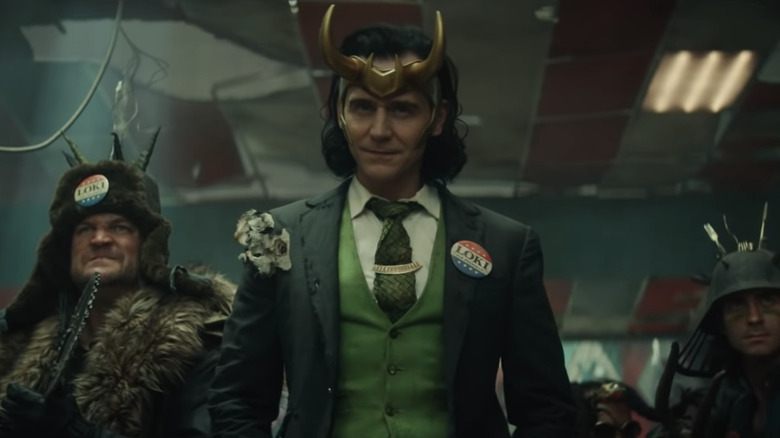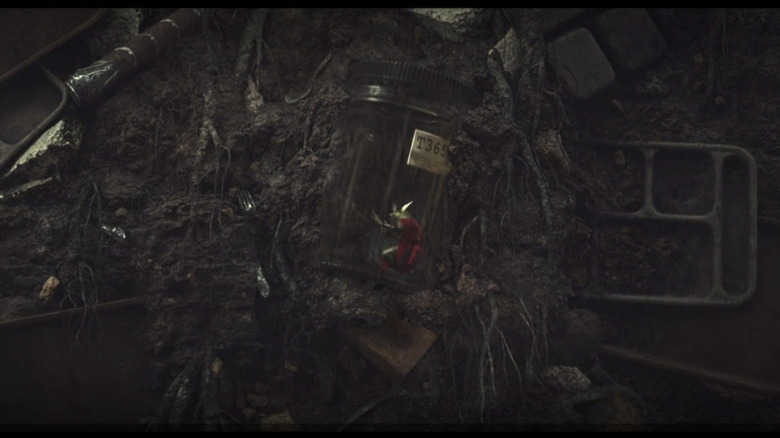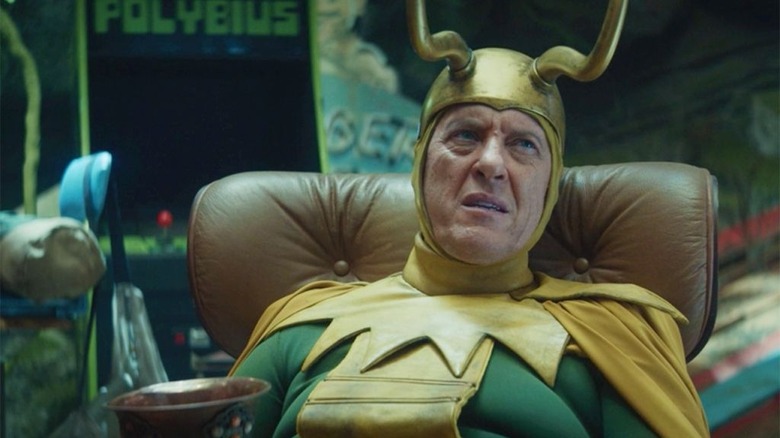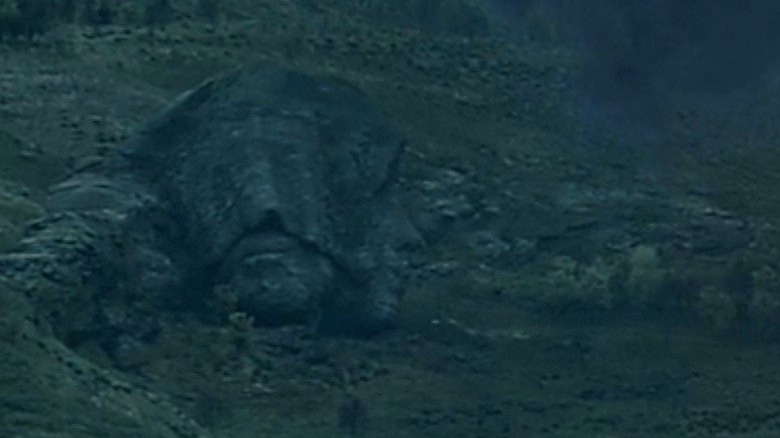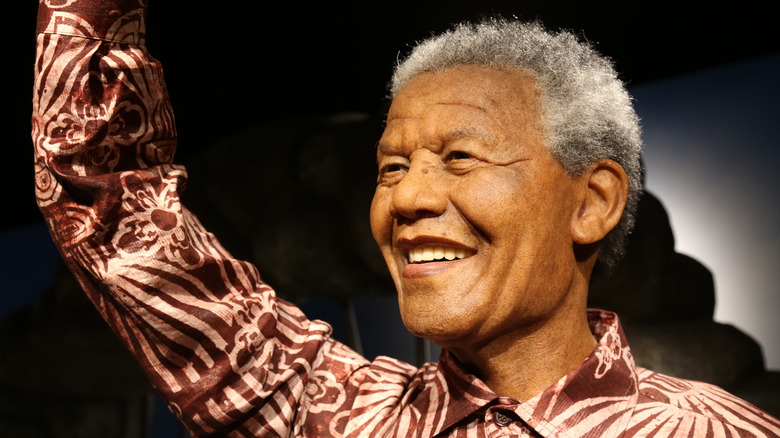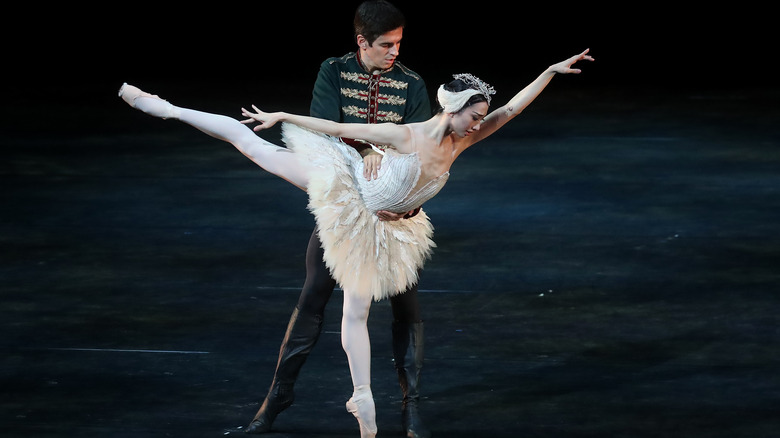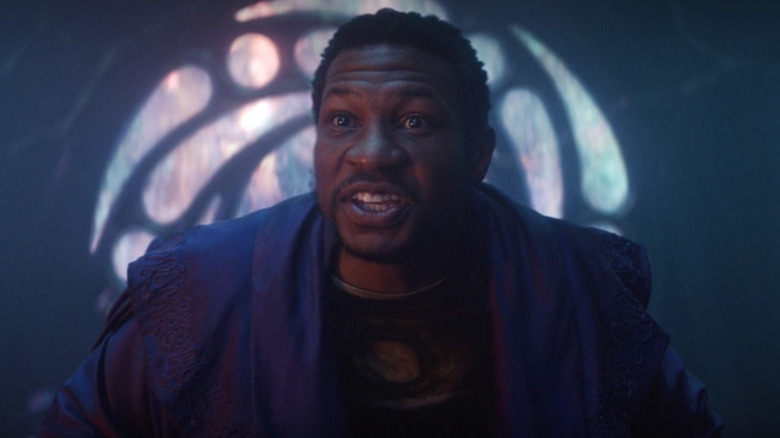Easter Eggs You Missed In Loki Season 1
"Loki" is the third Marvel series to premiere on Disney+, following the very successful "WandaVision" and "The Falcon and the Winter Soldier." The show's story picks up in 2012, after Loki (Tom Hiddleston) steals the Tesseract during the time heist in "Avengers: Endgame." It was revealed by Marvel Studios head Kevin Feige at SDCC 2019 that "Loki" would see the fallout of that theft, which immediately results in his capture by the TVA (Time Variance Authority). We learn very quickly in "Loki" that the TVA has been around for quite some time (ahem) and was created and perfectly crafted to protect its proper flow.
Run by people who are born and bred to work for the TVA, the bureaucracy routinely tracks and captures variants — beings who have strayed off their proper path. Straying can lead to catastrophic events, which creates the need for intervention. Loki is one of these variants, and he proves helpful in aiding Mobius M. Mobius (Owen Wilson) in his efforts to track another dangerous variant.
There is much to unpack along the way, and "Loki" is just as strange, if not more, than the frequently mind-bending "WandaVision." The story is complex, and as we watch the characters travel through time, things only get all the more confusing. The series is full of Easter eggs — something not uncommon for an MCU property. These hidden Marvel gems are abundant, especially in the introduction of new characters, agencies, and alternate timelines. Read on to see some of the big Easter eggs you might have missed in "Loki."
A sandy throwback
When Episode 1 of "Loki" kicks off, a brief recap of the events leading up to the series plays out. After Loki is captured at the finale of "The Avengers," we see him escorted by the superhero team to the bottom floor of Avengers tower. A disgruntled Hulk (Mark Ruffalo) causes a future Tony Stark (Robert Downey Jr.) to drop a briefcase containing the Tesseract, which then bounces in front of Loki's feet. The trickster grabs the cube and vanishes, disrupting the entire time heist.
We find out that this portal's other end was in Mongolia — specifically the Gobi Desert — where Loki drops out of the sky. His head sticks out of the sand as he lays on his back, the desert's landscape partly covering his green and gold garb. While it's a brief moment in the episode's intro, it's also a major callback to the MCU property that started it all: "Iron Man."
When Tony escapes from his captors in that film, he flies off into the sky, but he comes crashing down into the desert sand after his home-brewed suit malfunctions, breaking apart into hundreds of pieces and leaving him dazed on the ground. The shot with Loki is a nice nod to the first "Iron Man" and a pleasant parallel that depicts the aftermath of two men who have just escaped capture.
Nexus events
After Loki is captured by the TVA, he's taken to their headquarters. He signs some paperwork, walks through a temporal aura detector, and then takes a number as he waits to see a judge for his crimes against the timeline. While waiting, he's treated to an educational video produced by the TVA to explain to variants why they've been captured. Hosted by TVA mascot Miss Minutes, the video goes into detail about the creation of the TVA and how the Time Keepers monitor the timestream.
Miss Minutes then explains that when variants veer off their predetermined course, they create a "nexus event," which, if "left unchecked, could branch off into madness, leading to another multiversal war." This isn't the first time we've heard the word "nexus" in the Marvel Cinematic Universe — and the last time wasn't long before "Loki": One of the six "WandaVision" commercials seen during the series' show-within-a-show is an advertisement for Nexus antidepressants. Nexus will be a significant word and concept moving forward in the MCU, as evidenced by the title of the "Doctor Strange" sequel, "Doctor Strange in the Multiverse of Madness."
In "WandaVision," the Nexus drug was being advertised as a medicine for Wanda Maximoff's (Elizabeth Olsen) grief and anger — and also a reference to her role as a nexus being. "Loki" is poised to further explore what the term means in the MCU.
Minutemen
When Loki is apprehended in the Gobi Desert, several TVA officers arrive through a portal to capture him. These officers are known as Minutemen, which is almost certainly a nod to Marvel Comics' Minutemen based on their purpose and uniforms. First appearing in "Fantastic Four" #352, the Minutemen are charged with policing the timestream. As these TVA guards serve the same sort of purpose, their appearance is a nice Easter egg.
In the Marvel comics, the Minutemen are actually robots, not human beings as they appear to be in "Loki." However, it should be noted that at the beginning of Episode 1, a TVA worker asks Loki to clarify that he is not a "fully robotic being." Loki then asks the worker if there are people who don't know that they're robots. It's probably nothing more than a throwaway gag, but Marvel is nothing if not tricky. Who knows? These Minutemen look like living, breathing beings, but they could actually be artificial.
Ravonna Renslayer
Although she isn't mentioned by name in the first episode of "Loki," we know Gugu Mbatha-Raw's character is Marvel comics character Ravonna Renslayer. She's never been a judge or otherwise associated with the TVA in the comics, but she does have a lengthy history nonetheless. First appearing in "Avengers" #63 in 1965, Ravonna gives the MCU plenty of content to pull from.
An important thing to notice surrounding the character's history in the comics is her involvement with Kang the Conquerer. We know Kang will be a villain in the upcoming "Ant-Man: Quantumania," so it wouldn't be unreasonable to expect some sort of involvement from Ravonna there as well. In the comics, she's the daughter of King Carelius, the ruler of the last kingdom on Earth-6311 that Kang overtook. The conqueror spared their empire due to his adoration for Ravonna, but she was not so smitten with him.
The relationship between Kang and Ravonna is a long and complicated one, leaving the door open for many storylines for the MCU. The Avengers also play a large part in Kang and Ravonna's back and forth, further opening possible storylines for the latter.
Mobius M. Mobius
Before Episode 1 ("Glorious Purpose") debuted, it was revealed that Owen Wilson would be playing Mobius M. Mobius in "Loki." Mobius first appeared in "Fantastic Four" #353 in 1991 as a lower-level worker of the TVA. After exhibiting an exemplary work ethic, Mobius was promoted to upper management and eventually became a TVA judge. In "Loki," Mobius appears to be earlier in his career trajectory, but we could see the series end with him behind the bench.
As far as his appearance goes, Wilson sports a mustache, an essential attribute of the Marvel character. Mobius has a stark black mustache in the comics, partly due to the inspiration behind the character's appearance, which is based on Marvel Comics legend Mark Gruenwald. In fact, all the TVA workers in the comics are clones of Gruenwald — a knowing nod to his status as a Marvel continuity expert.
D.B. Cooper
In Episode 1, when Mobius plays scenes from Loki's past in a TVA interrogation room, the highlight reel includes an airplane hijacking that leaves Mobius howling. "I can't believe you were D.B. Cooper! Come on!" he tells Loki. The trickster then admits that he pulled it off because he lost a bet to Thor. Loki is seen being brought back to Asgard when Heimdall summons the Bifrost after he jumps out of the plane. Having Loki literally pulled out of thin air offers an excellent explanation for D.B. Cooper's real-life disappearance.
To this day, the explanation for Cooper's vanishing remains a mystery. According to the FBI, the mystery man hijacked an airplane on November 24, 1971. After telling a flight attendant that he had a bomb, he demanded $200,000 in $20 bills and four parachutes. After the plane landed in Seattle, all the passengers left, and the plane took off again with the Cooper, the pilot, and some crew members. The hijacker was given his requests, and he jumped out of the back of the plane somewhere between Seattle and Reno, Nevada. The mystery man, whose name probably wasn't D.B. Cooper, was never found, and the case was never closed.
Josta soda
Not every Easter egg that's hidden in an MCU property has something to do with Marvel Comics. Case in point: Josta soda makes an appearance in Episode 1 of "Loki." Mobius takes a sip of the beverage, which was only available for a few years in the 1990s. We didn't see the TVA travel to the '90s in Episode 1, so we know that at least somewhere before "Loki" begins, Mobius scooped some of the beverage up while he was visiting the decade for another reason. Given that time works differently in the TVA, it makes sense that Mobius might want to sip on a drink so high in caffeine.
Josta was a product of PepsiCo and one of the first big energy drinks to be mass-produced, but it didn't last long. Given that the market for these types of drinks in the '90s wasn't as robust as it is today, the product didn't sell well. Just as with former caffeine-fueled drinks like Surge and Vault, Josta developed a following of former drinkers who still hope to get the beverage back on grocery store shelves.
Oshkosh, Wisconsin
At the beginning of Episode 2, several Minutemen travel to Oshkosh, Wisconsin, in 1985, and arrive at a Renaissance Faire where they believe the Loki variant is hiding out. At first, it might appear like Oshkosh is a totally random place for the writers and producers of "Loki" to select for a scene like this, but as we're all well aware by now, nothing is ever random with the MCU.
Earlier we discussed Mark Gruenwald, the Marvel Comics legend who created many famous characters and served as an artist from time to time. Mobius' appearance isn't the only homage "Loki" pays to the late comic book writer, as it turns out he was also born in Oshkosh, Wisconsin, according to his New York Times obituary. The location of the Renaissance Faire is just another way for the MCU to honor Gruenwald, who played such a significant role in the comic book publisher's history.
#372
There are hundreds of floors that make up the TVA, which is full of winding hallways and curvy architectural designs. Loki and Mobius take several elevator rides during their time there, traveling to all different kinds of TVA departments. In Episode 2, they land on level 372, where Mobius instructs Loki to read through all of the variant's paperwork to see if he can come up with any theories or suggestions.
The floor number can be spotted just behind Loki for a brief moment, and is surrounded by levels of nothing but bookshelves overflowing with files. As with Oshkosh, Wisconsin, nothing in the MCU is random: The Time Variance Authority made its first appearance in "Thor" Vol. 1 #372 and was created by Walt Simonson and Sal Buscema. The use of 372 as one of the floor numbers in "Loki" is a nice nod to the organization's origins and suggests viewers should take a second look at any and all background details in the series.
Raganarok paperwork
Loki can only access his own files at the TVA, and after he obtains them he skims through documents and gets caught on a particularly devastating one. We get to witness Loki read about the events of Ragnarok, which he hasn't lived through at this point in time. While he's looking through the documents, we see some new tidbits of information about the event that we witnessed in "Thor: Ragnarok."
The paperwork shows that there were 9,719 casualties in what's described as a Class 7 Apocolypse. This means that Asgard was a relatively small planet with a population that only consisted of thousands. Mobius confirms that Ragnarok wiped out "most" of Asgard's people, and we know the survivors later end up living on Earth in New Asgard.
One of the more fun Easter eggs hidden in the Ragnarok paperwork is the mention of the Revengers, the makeshift superhero group assembled by Thor (Chris Hemsworth) that includes Valkyrie (Tessa Thompson), the Hulk (Mark Ruffalo), and Loki. The foursome bond together to escape Sakaar and are instrumental in the takedown of Hela (Cate Blanchett). Thor jokes about their group name in the film, but there's no joking about the fact that they helped save hundreds of Asgardians from death — justifying their mention in the document.
Roxxcart
In Episode 2, Loki, Mobius, and a team of Minutemen travel to Alabama in 2050. They're there to sniff out the missing variant who Loki suspects is hiding in apocalyptic events. The group arrives in a Roxxcart parking lot, and the glowing logo of the store name is too reminiscent of a famous Marvel Universe company to be ignored. The Roxxon Corporation — which has gone by many names — is an oil conglomerate that first appeared in 1974's "Captain America" #180.
Roxxon has worked with both SHIELD and HYDRA, but their alliance will always lie with whoever can fill their pockets the most. Blinded by dollar signs, Roxxon deals in heavily illicit activities, sometimes with the universe's biggest villains. In "Thor" Vol. 4 #6, Roxxon worked closely with Malekith to receive exclusive rights to mine on any planets he overtook. The corporation has also been hinted at in "Iron Man 2" and "Iron Man 3," while also being spoken of in other Marvel live-action projects like "Agents of S.H.I.E.L.D.," "Agent Carter," "Cloak & Dagger," and Netflix's "Daredevil." Whether this means they'll play a more significant role in the MCU going forward remains to be seen.
Lady Loki
There's been a long-standing rumor that Lady Loki would make an appearance in Loki, so when a female antagonist popped up toward the end of Episode 2, a casual fan and rumor-follower might just assume that we've got ourselves a Lady Loki! Well ... not so fast.
In the English credits at the end of the episode, actress Sophia Di Martino is listed as playing "The Variant." However, if you look at the Spanish credits, Elisa Beuter is credited as playing Sylvie. It's the same character, only the Spanish credit seems to be pretty name-specific. That name might ring a bell to longtime Marvel fans. It seems likely this Variant is actually Enchantress — a character who first battled Thor way back in 1964 in "Journey Into Mystery" #103. Enchantress' real name is indeed Sylvie.
Now, we've seen the MCU get cute before with cameos and such — looking at you, "WandaVision" — so we can't guarantee that this is Enchantress. Lady Loki still might pop up eventually in the series, or this is another of those silly MCU twists and Enchantress is the new Lady Loki.
The sacred timeline's fallout
After Sylvie sets off multiple reset charges at Roxxon in 2050, the sacred timeline is thrust into chaos. As Judge Renslayer watches the pandemonium in her office, her computer screen displays several locations that appear to be affected by Sylvie's meddling.
Many of these locations are popular MCU hotspots that we've visited before. Hala, Xandar, Sakaar, Ego, Titan, Vormir, and Asgard are all listed on Judge Renslayer's screen, with various dates written next to them. While some of these locations we've seen on more than one occasion in the MCU — like Asgard and Vormir — others have only been visited once.
Hala is the Kree home planet, where Carol Danvers (Brie Larson) trained on for many years in "Captain Marvel." Xandar made its appearance in "Guardians of the Galaxy," but we know the planet was decimated by Thanos (Josh Brolin) just before the events of "Avengers: Infinity War." We visited Sakaar, overseen by the Grandmaster (Jeff Goldblum), in "Thor: Ragnarok," while Titan is the home planet of Thanos that saw an epic battle between the villain and a faction of the Avengers in "Infinity War." Ego is, of course, the living planet that served as the setting for about much of "Guardians of the Galaxy Vol. 2."
Lamentis
Much of "Loki" Episode 3 is spent on Lamentis-1, a rocky, purple-skied moon facing imminent destruction. The episode is even named after Lamentis, which has briefly appeared in Marvel Comics. Debuting in 2007's "Annihilation: Conquest Prologue" #1, it lies on the outskirts of Kree space. That appearance is basically just a mention, which means that for all intents and purposes, Lamentis-1 is basically a blank slate for the Marvel Cinematic Universe — a perfect spot for "Loki" to continue delving into its narrative mysteries, in other words.
Loki and Sylvie arrive on Lamentis-1 after escaping from Ravonna and her Minutemen following a skirmish outside the elevator doors leading to the Time Keepers. They land on the moon in 2077, 12 hours before it's set to collide with its planet — an inconvenient apocalypse for them to hide in, but with their TemPad low on juice, one that forces them to make the best of a bad situation.
Postman
After Sylvie and Loki sneak on board the shuttle ferrying ticket-holders off Lamentis-1, they have time to start getting to know one another — so naturally, talk turns to their love lives. Sylvie remains as cagey as ever, but tells Loki she's managed to keep a long-distance relationship going with a "postman" as she runs from one apocalypse to another. At first, this sounds like a joke — as if she could maintain any kind of relationship given her current life path — but as it turns out, there's a very important Postman in Marvel Comics.
First appearing in 2002's "Morlocks" #1, Postman (a.k.a. David) is a mutant who lost control of his powers and accidentally wiped his wife's mind. He seeks refuge with the Morlocks based in Chicago and eventually becomes their leader. Postman ends up losing his mutant abilities thanks to the Scarlet Witch, whose "No More Mutants" decree in 2005's "House of M" #7 wipes the mutant gene from the vast majority of its carriers.
Sylvie and Postman don't appear to have a clear connection in the comics, but this potential name-drop could suggest that mutants will be arriving sooner than later in the MCU.
Another!
We're treated to some fun callbacks to earlier MCU chapters in "Loki," and Episode 3 is no exception. Once Loki and Sylvie work their way onto the Lamentis shuttle, they sit and converse in one of its upper-scale lounges. As they talk, Loki helps himself to two glasses of champagne, and Sylvie ends up falling asleep. When she wakes, her new travel companion has treated himself to more beverages, and he's putting on a show for the other travelers in the lounge.
After singing and giving cheers to Sylvie, Loki smashes a martini glass and yells "Another!" Loyal MCU fans will notice this nod to the first "Thor" film — the line and gesture are uttered by Thor (Chris Hemsworth) when he visits a diner with his new Earth pals Jane Foster (Natalie Portman), Erik Selvig (Stellan Skarsgård), and Darcy Lewis (Kat Dennings). After finishing a cup of coffee, Thor says, "This drink... I like it. Another!" and smashes his coffee mug on the ground, surprising all those around him. The line is one of the most quoted from "Thor" and has been immortalized in a popular GIF — something we now hope to see from this "Loki" callback.
Lady Sif
One of the biggest surprises to come in Episode 4 ("The Nexus Event") is the return of Jaimie Alexander as Lady Sif. We hadn't seen the character in the MCU since 2013's "Thor: The Dark World," and while we suspected the missing hero might be returning, her appearance was still shocking nonetheless. Sif's cameo was brief, and those unfamiliar with Norse mythology might have missed a famous story hiding in plain sight. When she first encounters Loki, Sif is holding a lock of her dark hair. She charges at Loki, beyond aggravated that he cut off her tresses, and calls him "pathetic" and "conniving" in addition to other unpleasant words. She aggressively knees and punches him, and Loki has to relive the event over and over as he's stuck in a time loop.
While it might seem like a storyline the "Loki" writers conjured up, they actually pulled it directly from the two character's mythologies. In the Norse myths, unlike the MCU, Sif is known for her long golden hair. In the Norse textbook "Prose Edda," Loki cuts off Sif's hair, which puts Thor — her husband — in a fit of rage. After his brother charges him with replacing her hair, Loki travels to Nidavellir, where the dwarves create new hair for Sif out of gold which would grow once placed on her head.
Time-Keepers
We finally get a look at the Time-Keepers in Episode 4 after their appearances were teased with TVA sculptures throughout earlier episodes of the series. When Loki and Sylvie are brought before them to be pruned, the Time-Keepers give them a chance to speak. We don't get much out of these mysterious beings, although their disdain for the Loki variants is obvious. With the help of Hunter B-15, who's had her memories of her pre-TVA life restored by Sylvie, the Lokis are able to battle and defeat their captors, and Sylvie severs the head of a Time-Keeper — only to discover that they're just androids. Beyond disappointed, Loki and Sylvie are left wondering who created the TVA. Marvel Comics might have some answers.
The Time-Keepers first appeared in 1979's "Thor" #282 and were created by He Who Remains — someone unmentioned during Episode 4. Also known as Him Who Remains — or more simply Him — this mystery being was the last director of the TVA, who put the Time-Keepers in place to oversee the organization. Originally, Him created the Time-Twisters in 1976's "Thor" #243, another trio of beings who strayed from their directive and began destroying Earth every 3000 years. While we don't know who specifically created the TVA, Him — or the Time-Twisters — might have some insight.
A familiar vantage point
In the first post-credits scene of "Loki," we meet four other versions of Loki after Ravonna Renslayer prunes our main variant, L1130. We'll touch on these characters next, but their immediate appearance is a fun Easter egg throwback to another famous Loki moment. In 2012's "The Avengers," Loki is pummeled into the ground by the Hulk (Mark Ruffalo) in Stark Tower. When he comes to several scenes later, he crawls up some stairs and turns around to see the entire superhero group staring him down. Loki's vantage point at this moment is similar to the one in Episode 4.
As he looks up at the Avengers — with a crouched Hawkeye at the center readying his bow — Loki is stared down by the group that towers over him. In Episode 4, the Loki variants are staring at him the same way, with a kid version of the character crouched down and backed by other Lokis. Just as we've seen in the series before, this camera work is a fun callback to an earlier MCU project moment.
The new Lokis
Different versions of Loki are teased in Episode 2 during a briefing Mobius gives to a group of Minutemen and other TVA workers before they take off to Oshkosh, Wisconsin. These variants are displayed on a hologram, which depicts five different versions of the character. None of these match the four new Lokis we meet in the Episode 4 post-credits scene. Thanks to the credits, we know these variants are Boastful Loki (DeObia Oparei), Classic Loki (Richard Grant), and Kid Loki (Jack Veal). There's also a creature we'll call Alligator Loki for now.
Grant's Classic Loki sports the traditional garb the character wore when he first appeared in 1962's "Journey Into Mystery" #85. Kid Loki has a much shorter history in the comics, first appearing in 2010's "Thor" #617. This incarnation came about after the original Loki died, but he was reborn as a child who eventually joins the Young Avengers. The backgrounds on our other two variants are vague, but Boastful Loki's possession of a hammer could be a nod to 2020's "Thor" #4. In this comic, Thor's brother is able to lift Mjolnir while on Jotunheim. This is at least some sort of confirmation that a Loki variant is worthy. As far as the alligator, there seems to be no history of this character in the comics. We've seen a frog version of Thor before, aka Throg the Frog of Thunder, in "Thor" #364, so why not an Alligator Loki?
Qeng Tower
At the beginning of Episode 5 ("Journey Into Mystery"), we travel through a destroyed cityscape full of decrepit buildings. Most of these structures seem like filler to emphasize the destruction, but there's one significant Easter egg hidden within the rubble that's worth noting. Toward the end of the camera pan, a building on the right reads "Qeng" at the top of it. Marvel Comics fans should know this famous name as it's related to a major villain who's set to appear in the MCU.
This tower represents Qeng Enterprises, which was first mentioned in 2015's "Avengers: Ultron Forever" #1, when a past Thor tries to warn Vision about the "new Qeng dy–" before being interrupted by Thor from the future. And if you thought the Qeng Tower looked like the Avengers Tower, you weren't wrong. We learn that Stark Industries sold the building to the new company in 2015's "Avengers" #0, when Vision brings it up in a conversation with Scarlet Witch.
As for the CEO of Qeng, that's Mr. Gryphon, aka Nathaniel Richards, who exists on Earth-6311 — an alternate version of Earth-616 (the reality where all the main Marvel stuff goes down). Nathaniel Richards is also known as Kang the Conqueror, as the latter was split into two different versions of himself due to a timestream error. It's a complicated story from 2015's "All-New, All-Different Avengers" #1, but this nod to Kang — a major villain we know will appear in "Ant-Man and the Wasp: Quantumania" — is something that we can't ignore.
Alioth
During Episode 5, one of the first things we see in the Void is a menacing purple-black cloud with a monstrous face within it. Known as a trans-temporal entity, Alioth doesn't exist in any reality but what the comics describe as Temporal Limbo. The being is the biggest enemy of Kang the Conqueror, and its empire is bigger than his foe's. Alioth first appeared in 1993's "Avengers: The Terminatrix Objective" #1 and is known for its absorption powers, which we saw play a huge role in Episode 5. Alioth is drawn to living beings more than anything and has the power to disintegrate them as soon as it encompasses them.
In the MCU, it appears as if Alioth lives within the Void at the end of time, unlike its location in the comics. It's also being used to protect the person or entity behind the Time Keepers, who many now suspect to be Kang. If this is the case in the MCU, the two would be on the same side, a massive shift from their comic book origins.
Thanos-Copter
In a move we never thought would happen, the Thanos-Copter became canon in the Marvel Cinematic Universe thanks to "Loki" Episode 5. When the Mad Titan finally perished in "Avengers: Endgame," it looked like we might never see the famous aircraft, but now, we know why we never did. The Thanos-Copter first appeared in 1979's "Spidey Super Stories" #39 and was a helicopter the villain used one time to attack Hellcat, a popular Marvel hero who fought the Titan as he tried to obtain the Cosmic Cube.
Thanos also picked up Deadpool in the helicopter, who he'd hired to help him steal the cube, and it's such a shame we never got to see that scene play out on the big screen. Fortunately, "Loki" Episode 5 paid homage to a great — and frequently mocked — comic book moment. The Thanos-Copter matched its comic book appearance exactly, with its bright yellow paint and the Titan's name written across it in large bold letters.
Vote Loki
We knew we'd be getting a version of the trickster god from the classic "Vote Loki" comic after he appeared in several trailers for the series. And he finally arrived in Episode 5 but only for a brief scene where a scuffle breaks out between a gaggle of Lokis. As for the variant's origin story, the four-part comic series debuted in June 2016 and was a satire on the United States presidential election of the same year. In the fourth and final issue, Loki concedes the race.
In the comics, Loki's campaign is based on his honesty about how he's going to lie to the American public. The citizens eat it up, except for Nisa Contreras, a reporter from the Daily Bugle, who's trying her best to take him down. It's definitely one of the weirdest Loki stories of all time, complete with "Political Action Cults" sacrificing goats to earn Loki the win and staged attacks involving HYDRA agents. And we're incredibly glad this dapper and politically ambitious Loki got to show up on the screen, even if it was only for a few minutes.
Throg
Just before the Loki group makes their way down to their secret hideout, we see different layers of ruble above their little base. And buried in all this debris, we get a glimpse of Mjolnir and a small glass jar with "T365" written on it. Trapped inside this jar is a tiny version of Thor ... and one who's a bit more amphibious than we're used to seeing the God of Thunder. Known as Throg, this powerful frog version of Thor first appeared in "Thor" #364, although #365 is more significant for the character because it's where he lifted Mjolnir and became the Thunder Frog officially.
This coincides with Mjolnir being just out of Throg's reach in the episode, as he's trapped in the glass jar. "Thor" #365 also heavily features Loki, who suspects something is afoot with his brother. In a hilarious storyline where Thor helps an army of frogs battle an army of rats, Harokin — a famous deceased Asgardian — impersonates the God of Thunder on their home planet. Loki suspects something isn't right with this Thor and eventually discovers him to be the famous foe.
More American mysteries
Just as with D.B. Cooper in Episode 1, Episode 5 of "Loki" further explained some great American mysteries. The first to appear in "Journey Into Mystery" was "Polybius" — an arcade game long considered an urban legend. The legend of "Polybius" suggests this fictitious '80s game was real and run by the government as a psychological experiment. It was supposedly created to test mind control on users, but the arcade game was never found. It looks like it was swooped up by the TVA and sent to the place where urban legends go to die.
Toward the end of "Episode 5," we also see the USS Eldridge fall out of the sky and into the Void. Unlike "Polybius," the famous naval ship was an actual thing. In 1943, it was alleged that the ship was made invisible, according to Naval History and Heritage Command, as part of the famous Philadelphia Experiment. As some claim, it was also apparently teleported from Philadelphia and Norfolk, Virginia, and back again. Crew members who were on board reportedly went insane, and the story was so bizarre it was adapted into a time-travel movie — "The Philadelphia Experiment" — in 1984.
MCU relics
Since Episode 5 mostly took place in the Void, set designers had a major opportunity to include an incredible amount of Easter eggs from the MCU's past. Some of these include "Ant-Man" villain Yellowjacket's helmet in the first act, which we saw as we panned over the landscape, and Ronin's Dark Aster also makes a brief appearance during another shot behind Richard Grant's Classic Loki
We also get a brief look at a demolished Helicarrier sitting in the wasteland, similar to how we saw one in "Deadpool" during the film's final battle scene. Also, in the vast devastation across "Loki" Episode 5 is what appears to be a stone face of the Living Tribunal — which we know isn't an MCU relic ... yet. One of the most important entities in Marvel Comics is the character who first appeared in "Strange Tales" #157 from 1967. The Living Tribunal basically oversees everything, ever, in every reality. Serving as somewhat of a judge of the entire cosmic universe and all of its realities, the Tribunal is more powerful than all of the Infinity Stones combined — and eternity and infinity themselves.
An emotional intro
While the Marvel Studios animated logo rolls at the beginning of Episode 6, we hear Steve Rogers and Peggy Carter's song "It's Been a Long, Long Time" play. As the tune begins, several famous lines uttered throughout the MCU can be heard, including:
- "Way to go, Tic-Tac!" — Sam Wilson in "Captain America: Civil War"
- "That's how you punch." — Hope Van Dyne in "Ant-Man"
- "Wakanda forever!" — King T'Challa in "Avengers: Infinity War"
- "You wouldn't have heard of me." — Scott Lang in "Ant-Man"
- "Let me put you on hold." — Natasha Romanoff in "The Avengers"
- "Dance-off, bro." — Peter Quill in "Guardians of the Galaxy"
- "He's a friend from work!" — Thor in "Thor: Ragnarok"
- "I can do this all day." / "Yeah, I know." — Steve Rogers in "Avengers: Endgame"
- "I'll show you ferocity." — Hank Pym in "Ant-Man"
- "Higher, further, faster, baby." — Carol Danvers in "Captain Marvel"
- "We have a Hulk." — Loki in "Avengers: Infinity War"
- "We're gonna jump on that spaceship and get out of here. Wanna come?" — Korg in "Thor: Ragnarok"
- "Who the hell is Bucky?" — Bucky Barnes in "Captain America: The Winter Soldier"
- "Puny God." — Hulk in "The Avengers"
- "You are an Avenger." — Clint Barton in "Avengers: Age of Ultron"
- "That's my secret, Captain. I'm always angry." — Hulk in "The Avengers"
- "What is grief if not love persevering?" — Vision in "WandaVision"
Real-world heroes get their moments
There are several muffled lines at the end of the aforementioned list from other MCU installments, but a few other familiar voices can be heard throughout the introduction as well. As we view the timeline's physical expression, voiceovers can be heard from several real-life heroes. The first comes from Neil Armstrong, saying "One small step for man..." followed by Greta Thunberg shouting, "How dare they!" Malala Yousafzai can be heard saying, "My dream...," followed by Nelson Mandela saying "We have fought for the right to experience peace." These real-world quotes are wrapped up with Maya Angelou saying, "I will rise."
In addition to serving as a sweet look back at the MCU's past, this introduction also offers a nod to the franchise's rapidly approaching multiverse. After all, as the MCU begins to embrace the concept of countless realities, who's to say we aren't part of the whole phenomenon? Slipping a meta brain-bender into the opening credits — that's so "Loki."
Swan Lake
There's a lot to unpack in the first two minutes of Episode 6. After "It's Been a Long, Long Time" fades out, Tchaikovsky's main score from "Swan Lake" fades in. The famous ballet centers around Odette and Odile, two versions of the same character. Odette is a cursed queen who is forced to live her life as a swan during the day and a human at night. Odile is the opposite in all respects, a bewitching presence who disguises herself as Odette in order to trick Prince Siegfried into falling for her. In the ballet, the two parts are often played by the same dancer.
The thought put into this parallel deserves all the applause in the world. Loki and Sylvie's story is much like that of "Swan Lake," as it's essentially two versions of the same character battling one another. While the ballet ends on a rather happy note, with Odette and Prince Siegfried coming together and living happily ever after, we don't go into Episode 6 expecting happy endings for Loki or Sylvie anytime soon.
Kang the Conqueror
In Episode 5, all signs seem to be pointing to the impending appearance of Kang the Conqueror in the finale. Episode 6 ("For All Time. Always") confirms those suspicions, as Kang appears in the flesh in the Citadel at the End of Time. Jonathan Majors was confirmed to play Kang in the upcoming "Ant-Man and the Wasp: Quantumania" in 2020, so while his name is never uttered in "Loki" Episode 6, hardcore MCU fans knew who he was as soon as he appeared onscreen. (Miss Minutes introduces him as He Who Remains, the TVA string-puller our heroes have been questing for.)
Kang's history in the comics is long and rather confusing, creating countless possibilities for the MCU. First appearing in 1964's "The Avengers" #8, Kang is born Nathaniel Richards and lived on Earth-6311, an alternate version of the main Marvel Comics reality, Earth-616. After discovering time travel, he journeys to ancient Egypt and becomes Pharaoh Rama-Tut, but is met with resistance by a time-traveling Fantastic Four, setting up a long and incredibly convoluted chain of events that's seen him battle and ally with numerous Marvel characters during the ensuing decades. Kang also has significant ties to Ravonna, and with her on the loose as the "Loki" finale closes, it's hard not to assume she'll meet up with one of the many versions of Kang who seem likely to appear as the MCU's Phase 4 moves forward.
